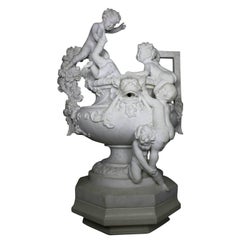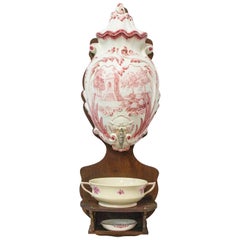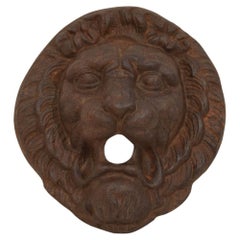Joseph Reynés I Gurgui Furniture
1850-1926
Joseph Reynés I Gurgui is a Catalan sculptor, also known as Reynesy-Gurgui, Spanish school. He studied at the Ecole de la Llotja, studied for a time in Paris, in the workshops of the great French sculptors Jean-Baptiste Carpeaux (1827–75) and Carrier-Belleuse (1824–87). Gurgui devoted himself mainly to interior decoration. His works were profoundly marked by a French influence. Gurgui exhibited in Paris in 1895, where he received an honorable mention. In 1890, he obtained the first medal in Madrid for The Violinist.
to
1
1
1
1
1
1
1
1
1
1
1
1
1
12,295
3,886
2,483
2,227
Creator: Joseph Reynés I Gurgui
A French 19th Century Carved Marble Whimsical Figural Urn Fountain with Children
By Joseph Reynés I Gurgui
Located in Los Angeles, CA
A very fine large, rare and charming, French, 19th century. Belle Époque carved white marble whimsical figural urn fountain depicting children climbing on an urn with flowers and garlands, influenced in the Louis XV style, by Joseph Reynés I Gurgui (Barcelona, 1850-1926). Signed: Reynes. Barcelona, circa 1890.
An almost identical Carrara marble fountain also by Josep Reynés carved in 1893 currently at the Parc de la Ciutadella in Barcelona, Spain.
Measures: Overall height: 55 inches (140 cm)
Marble height: 49 inches (124.5 cm)
width: 37 inches (94 cm)
depth: 30 inches (76.3 cm)
Joseph Reynes Gurguí (Barcelona, 1850 - 1926) is a Catalan sculptor, also known as Reynesy-Gurgui, Spanish school.
He studied at the Ecole de la Llotja, studied for a time in Paris, in the workshops of the great French sculptors Jean-Baptiste Carpeaux (1827-1875) and Carrier-Belleuse (1824-1887). He devoted himself mainly to interior decoration. His works were profoundly marked by a French influence. He exhibited in Paris in 1895 where he received an honorable mention. In 1890 he obtained the first medal in Madrid for "The Violinist".
Literature:
E. Benezit Dictionaire des Peintres, Sculpteurs, Dessinateurs et Graveurs by Grund - Nouvelle Edition, 1976 - Volume 8, Page 714.
Cristina Mensoza, Ramon Casas...
Category
19th Century Spanish Louis XV Antique Joseph Reynés I Gurgui Furniture
Materials
Marble
$98,450 Sale Price
21% Off
Related Items
French Faience Wall Fountain, 19th Century
Located in Labrit, Landes
Wall fountain set: original water tank and soap dish and wooden support, lavabo.
France, mid-19th century
Unseal plant holder
Very good condition
Shipping:
86 x 18 x 30 cm, 7 kg.
Category
Mid-19th Century French Antique Joseph Reynés I Gurgui Furniture
Materials
Faience, Chestnut
$898 Sale Price / set
20% Off
H 33.86 in W 11.82 in D 7.09 in
French, 19th Century Cast Iron Lion Fountain Head
Located in Buisson, FR
Wonderful cast iron fountain head with a great expression, France, circa 1850-1900. Weathered.
H:27cm W:25,5cm D:10cm
Category
19th Century French French Provincial Antique Joseph Reynés I Gurgui Furniture
Materials
Iron
$1,153 Sale Price
45% Off
H 10.63 in W 10.04 in D 3.94 in
19th Century Antique Fountain Basin in Marble from Sicily
Located in West Palm Beach, FL
An antique rectangular fountain basin or in the style of the late Hellenistic period with minor repairs. This garden ornament features impressive mythological carvings of the art mus...
Category
Early 19th Century Italian Hellenistic Antique Joseph Reynés I Gurgui Furniture
Materials
Marble
19th Century French Cast Stone Fountain
Located in Winter Park, FL
A 19th century French Neoclassical style cast stone fountain. Shell shaped basin with a pair of dolphin spouts is held aloft by a cherub, or putto, his foot resting on a turtle. Weat...
Category
19th Century French Antique Joseph Reynés I Gurgui Furniture
Materials
Cast Stone
French, 19th Century Cast Iron Lion Fountain Head
Located in Buisson, FR
Wonderful and rare small cast iron fountain head with a great expression, France, circa 1850-1900. Weathered
H:20cm W:18,5cm D:8,5cm
Category
19th Century French French Provincial Antique Joseph Reynés I Gurgui Furniture
Materials
Iron
$585 Sale Price
44% Off
H 7.88 in W 7.29 in D 3.15 in
19th Century Italian Antique Marble Wall Fountain
Located in West Palm Beach, FL
An antique Breccia marble wall fountain. The scalloped water basin is supported by a dolphin sitting on a square base. The backsplash has a very detailed carved mask as the spout. Mi...
Category
19th Century Italian Antique Joseph Reynés I Gurgui Furniture
Materials
Marble
19th Century French Limestone Wall Fountain
Located in Beervelde, BE
One of a kind French wall fountain in limestone. Typical LXIV style of the 19th century.
Amazing and grand fountain for a bespoke luxury lifestyle design.
The head stone measures:
7...
Category
19th Century French Louis XIV Antique Joseph Reynés I Gurgui Furniture
Materials
Limestone
19th Century Country French Fountain with Porcelain Reservoir and Basin
Located in Dallas, TX
19th century Country French fountain with porcelain reservoir and basin is a charming ode to a bygone era! Back before hot and cold running water, it was desirable for family members...
Category
Early 19th Century French French Provincial Antique Joseph Reynés I Gurgui Furniture
Materials
Porcelain, Oak
$1,480
H 68 in W 21.5 in D 15 in
Italian Ancient Marble Sculpture Fountain, Late 16th Century
Located in Milano, IT
Sea monster
Carrara marble mouth fountain
Italy, late 16th century
It measures 13.8 x 31.5 x 18.9 in (35 x 80 x 48 cm)
State of conservation: some small evident gaps and widespread signs of wear due to outdoor exposure. The gray marks crossing it do not come from restoration, but are rather the natural veins of the marble.
This work has some morphological characteristics typically associated with the iconography of the sea monster: an elongated muzzle, sharp teeth, protruding eyes, elongated ears, and a coiled serpent's tail.
An in-depth series of studies on artistic depictions of the sea monster attempted to verify how this symbol evolved in antiquity in the European and Mediterranean contexts and how it gradually changed its image and function over time. The iconography itself is mutable and imaginative and its history is rich with cultural and artistic exchange, as well as the overlapping of ideas. This occurred so much that it is difficult to accurately pinpoint the "types" that satisfactorily represent its various developments.
However, we can try to summarize the main figures, starting from the biblical Leviathan and the marine creature that swallowed Jonah (in the Christian version, this figure was to become a whale or a "big fish", the “ketos mega”, translation of the Hebrew “dag gadol”). Other specimens ranged from the dragons mentioned in the Iliad (which were winged and had legs) to "ketos” (also from Greek mythology), the terrifying being from whose Latinized name (“cetus”) derives the word "cetacean". See J. Boardman, “Very Like a Whale” - Classical Sea Monsters, in Monsters and Demons in the Ancient and Medieval Worlds, in Papers presented in Honor of Edith Porada, Mainz am Rhein 1987, pp. 73-84).
In Italy the monster underwent yet further variations: it can be found in Etruscan art on the front of some sarcophagi representing the companion of souls, while among the Romans we find the “Pistrice” (cited by Plinio in Naturalis Historia PLIN., Nat., II 9, 8 and by Virgilio in Eneide: VERG., Aen., III, 427), which appeared in the shape of a stylized hippocampus or a very large monstrous cetacean and evolved into a hideous being with a dragon's head and long webbed fins.
During the Middle Ages, the sea monster was the object of new transformations: at this time, it is often winged, the head is stretched like a crocodile, the front legs are often very sharp fins - sometimes real paws - until the image merges with dragons, the typical figures of medieval visionary spirituality widely found throughout Europe (on this topic and much more, see: Baltrušaitis, J., Il Medioevo fantastico. Antichità ed esotismi nell’arte gotica, Gli Adelphi 1997).
In Italy during the 15th and 16th centuries, the revival of classicism - representative of the humanistic and Renaissance periods - led to a different reading of these "creatures". Indeed, the sea monster was also to find widespread use as an isolated decorative motif, especially in numerous fountains and sculptures where dolphins or sea monsters were used as a characterizing element linked to water (on this theme see: Chet Van Duzer, Sea Monsters on Medieval and Renaissance Maps, London, The British library, 2013).
From the morphological point of view, the "sea monsters" of this period are mostly depicted as hybrid figures, in which the body of a mythological or real being (a hippocampus, a sea snake, a dolphin), is joined to a head with a rather indistinct appearance. It was usually characterized by large upright ears, an elongated snout, sharp teeth and globular, protruding eyes; a complex and indefinite figure, both from the symbolic point of view and from that of its genesis.
The work we are examining is placed as a cross between the medieval sea serpent and the Renaissance dolphin, with stylistic features which recall the snake as often used in heraldry (such as the "snake" depicted in the coat of arms of the Visconti - the lords and then dukes of Milan between 1277 and 1447 - and which, for some, may be derived from the representations of the “Pistrice” that swallowed Jonah).
In the search for sources, Renaissance cartography and in particular woodcuts should not be neglected. See for example the monsters of Olaus Magnus, from the editions of the “Historia de gentibus septentrionalibus” (“History of the peoples of the north”) and the natural histories of Conrad Gesner, Ulisse...
Category
16th Century Italian Renaissance Antique Joseph Reynés I Gurgui Furniture
Materials
Carrara Marble
Fabulous 18th-19th century French carved stone fountain with Poseidon bust
Located in Richmond, VA
Incredible 18th-19th century hand carved limestone fountain depicting a bust of Poseidon, complete with coral in his hair. Found in the south...
Category
19th Century French Antique Joseph Reynés I Gurgui Furniture
Materials
Limestone
$21,000
H 88 in W 50 in D 32 in
Antique 19th Century Marble Fountain with Dolphins and Putto
Located in London, GB
An antique marble fountain in the Baroque style, with a tripartite dolphin base each with a water spout in their mouths, their tails supporting the generous lobed bowl, which is topp...
Category
Mid-19th Century European Rococo Antique Joseph Reynés I Gurgui Furniture
Materials
Marble
19th Century French Cast Iron Water Pump Fountain
Located in Rio Vista, CA
Monumental 19th century French water pump fountain made by Louis Jonet. This large cast iron piece would have been mounted above a large stone trough to catch water. Reminiscent of t...
Category
19th Century French Napoleon III Antique Joseph Reynés I Gurgui Furniture
Materials
Iron
Joseph Reynés I Gurgui furniture for sale on 1stDibs.
Joseph Reynés I Gurgui furniture are available for sale on 1stDibs. These distinctive items are frequently made of stone and are designed with extraordinary care. There are many options to choose from in our collection of Joseph Reynés I Gurgui furniture, although gray editions of this piece are particularly popular. Many of the original furniture by Joseph Reynés I Gurgui were created in the louis xv style in spain during the 19th century. Prices for Joseph Reynés I Gurgui furniture can differ depending upon size, time period and other attributes — on 1stDibs, these items begin at $147,500 and can go as high as $147,500, while a piece like these, on average, fetch $147,500.


